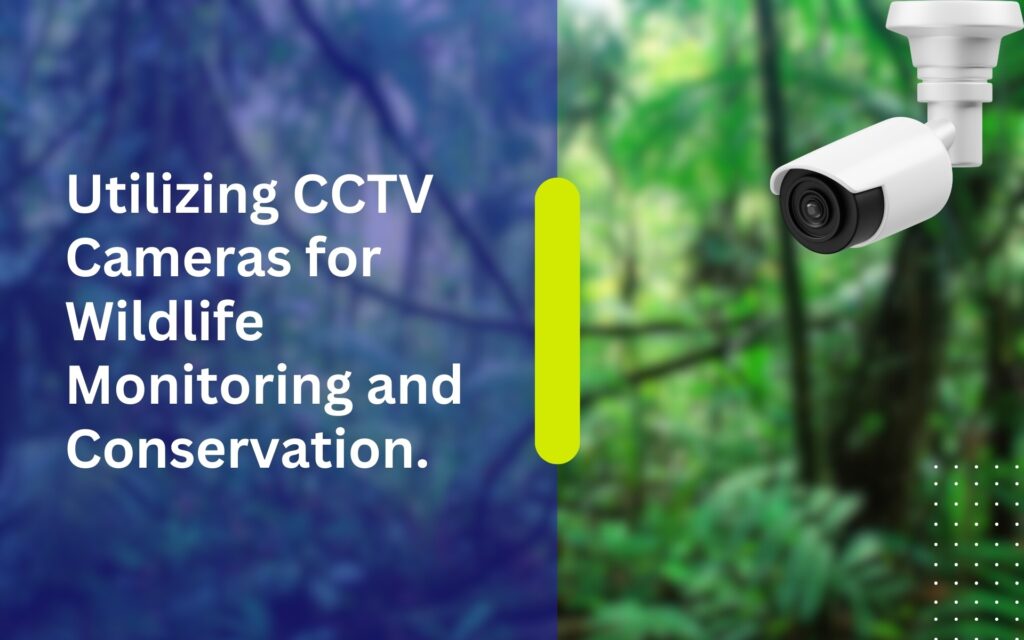The On-the-Job Training Experience of Mark Edwin E. Huyo-a Introduction On-the-Job Training (OJT) serves as one of the most significant components of an Information Technology student’s academic journey. It bridges the gap …
Utilizing CCTV Cameras for Wildlife Monitoring and Conservation.

Introduction
The realm of wildlife monitoring and conservation stands at the forefront of global efforts to preserve biodiversity and safeguard fragile ecosystems. In this endeavor, the integration of cutting-edge technologies has revolutionized traditional approaches, offering innovative solutions to age-old challenges. Among these technologies, Closed-Circuit Television (CCTV) cameras have emerged as indispensable tools, enabling researchers and conservationists to delve deeper into the intricate lives of wildlife species. This article delves into the multifaceted role of CCTV cameras in wildlife monitoring and conservation, unraveling their applications, benefits, challenges, and future prospects.
Understanding CCTV Cameras in Wildlife Monitoring
CCTV cameras, often referred to as trail cameras or camera traps, represent a pinnacle in the fusion of technology and conservation biology. These compact devices are equipped with motion sensors and infrared illumination, allowing them to capture high-resolution images and videos of wildlife in their natural habitats. Strategically positioned across diverse ecosystems, CCTV cameras serve as silent sentinels, silently observing the comings and goings of animals without disrupting their behavior or habitat.
Applications of CCTV Cameras in Wildlife Monitoring and Conservation
1. Population Surveys
One of the primary applications of CCTV cameras is in conducting population surveys of wildlife species. By capturing images of individual animals as they traverse through camera-trap sites, researchers can estimate population densities, track changes in distribution, and monitor demographic trends over time. These surveys provide crucial insights into the health and dynamics of wildlife populations, forming the cornerstone of evidence-based conservation strategies.
2. Behavior Studies
CCTV cameras offer a window into the secret lives of wildlife, unveiling the intricacies of their behavior, social interactions, and ecological roles. From foraging patterns and territorial displays to courtship rituals and parental care, these cameras document a rich tapestry of behaviors that shape the fabric of natural ecosystems. By analyzing these behavioral data, researchers gain deeper insights into species ecology, adaptability, and response to environmental changes.
3. Habitat Assessment
The deployment of CCTV cameras facilitates comprehensive assessments of habitat suitability and integrity. By monitoring wildlife activity and habitat use, researchers can identify critical habitats, delineate wildlife corridors, and evaluate the impact of habitat fragmentation and degradation. This information is vital for prioritizing conservation actions, restoring degraded habitats, and mitigating anthropogenic threats to biodiversity.
4. Illegal Activity Detection
In addition to monitoring wildlife, CCTV cameras serve as vigilant guardians against illegal activities such as poaching, logging, and encroachment. Positioned strategically along wildlife corridors and sensitive ecosystems, these cameras capture evidence of illicit activities, enabling law enforcement agencies to apprehend perpetrators and enforce wildlife protection laws effectively. Moreover, the presence of CCTV surveillance acts as a deterrent, dissuading would-be offenders from engaging in illegal activities.
Benefits of Utilizing CCTV Cameras for Wildlife Monitoring and Conservation
1. Non-Invasive Monitoring
Unlike traditional methods such as direct observation or trapping, CCTV cameras offer a non-invasive means of monitoring wildlife. By operating remotely and autonomously, these cameras minimize human disturbance, allowing animals to behave naturally without fear or disruption.
2. Cost-Effectiveness
The cost-effectiveness of CCTV cameras makes them a preferred choice for long-term monitoring projects, especially in remote or inaccessible areas. Once deployed, these cameras require minimal maintenance and can operate continuously for extended periods, capturing valuable data at a fraction of the cost of manned surveillance or aerial surveys.
3. High Data Quality
CCTV cameras capture high-resolution images and videos, enabling researchers to discern fine details and individual identification markings. This high data quality enhances the accuracy and reliability of wildlife monitoring studies, providing a wealth of information for scientific analysis and decision-making.
4. Long-Term Monitoring
With advancements in battery technology and storage capacity, modern CCTV cameras can operate continuously for months or even years on end. This long-term monitoring capability allows researchers to track seasonal variations, long-term trends, and population dynamics, providing invaluable insights into ecosystem dynamics and resilience.
Challenges and Limitations of CCTV Cameras in Wildlife Monitoring
Despite their numerous benefits, CCTV cameras are not without their challenges and limitations:
1. Technical Issues
CCTV cameras are prone to technical malfunctions, including battery failures, sensor errors, and memory card issues. These technical glitches can compromise data collection efforts and necessitate regular maintenance and troubleshooting to ensure optimal performance.
2. Data Management
The sheer volume of data generated by CCTV cameras can overwhelm researchers, posing challenges in data storage, organization, and analysis. Implementing efficient data management protocols and leveraging automated analysis tools are essential for streamlining workflows and extracting meaningful insights from camera-trap data.
3. Ethics and Privacy Concerns
The use of CCTV cameras in wildlife monitoring raises ethical considerations regarding animal welfare and privacy rights. Researchers must adhere to strict ethical guidelines and obtain necessary permits and approvals before deploying cameras in protected areas. Moreover, measures should be implemented to safeguard the privacy of local communities and indigenous peoples who may inadvertently be captured on camera.
4. Limited Coverage
Despite their versatility, CCTV cameras have limited coverage compared to other monitoring techniques such as satellite imagery or drone surveys. Strategic placement of camera traps and careful selection of monitoring sites are essential to maximize camera effectiveness and capture representative data across diverse habitats and ecosystems.
Future Directions and Innovations
Looking ahead, ongoing advancements in technology hold promise for enhancing the capabilities of CCTV cameras for wildlife monitoring and conservation:
1. Artificial Intelligence (AI) Integration
The integration of AI-powered image recognition algorithms can automate the identification and classification of wildlife species captured by CCTV cameras. By leveraging machine learning techniques, researchers can expedite data analysis, improve accuracy, and extract valuable insights from vast datasets.
2. Wireless Connectivity
The integration of wireless communication technologies such as 5G networks enables real-time transmission of camera data, allowing researchers to monitor wildlife remotely and respond promptly to conservation threats. Moreover, wireless connectivity facilitates remote camera management, firmware updates, and troubleshooting, enhancing operational efficiency and reliability.
3. Sensor Fusion
Combining CCTV cameras with other sensor technologies such as acoustic recorders or environmental sensors enables comprehensive monitoring of wildlife and ecosystem dynamics. By integrating multiple data streams, researchers can gain a holistic understanding of species interactions, habitat conditions, and environmental changes, facilitating more informed conservation decisions.
Conclusion
In conclusion, CCTV cameras represent a paradigm shift in wildlife monitoring and conservation, offering unprecedented insights into the hidden world of wildlife. Their non-invasive nature, cost-effectiveness, and high data quality make them indispensable tools for researchers and conservationists striving to protect biodiversity and preserve natural ecosystems. Despite challenges such as technical issues and ethical considerations, ongoing technological innovations hold promise for further enhancing the effectiveness and efficiency of CCTV-based monitoring systems. By harnessing the power of CCTV cameras, we can unlock the mysteries of the natural world, deepen our understanding of wildlife ecology, and chart a course towards a more sustainable future for generations to come.
Related Articles
The On-the-Job Training Experience of Gester Samson. Introduction. The On-the-Job Training journey marks a crucial stage for students as they step into real work environments and apply what they have learned in …
The On-the-Job Training Experience of Francis Daniel Austria. Introduction On-the-Job Training serves as a transformative phase for students as they transition from academic learning to real-world environments. For Francis Daniel Austria, the …

